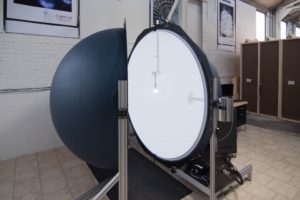LM-79 Color Measurements
LM-79 Color Measurements are used to communicate information about the color of a light source. This color information can define the apparent color of the source and the spectrum of the light produced. The spectrum of the light can then be used to predict the way that objects will look when illuminated by the source. There are multiple color metrics defined by many different organizations (including the CIE and IES), and LightLab International Allentown, LLC has designed a test report that provides the primary metrics in an easy-to-read format.

LM-79 measurements are primarily used for the measurement of light according to its perception by the human eye (a process called photometry or photometric measurement). The standard defines the test equipment, methods, and conditions that are needed to make accurate and reproducible measurements of the light output and electrical power consumed by LED products. The testing methods generally break down into two methods, angularly scanned and integrated measurements goniometer measurements, and integrating sphere measurements. The first version of this standard was LM-79-08 and it was published in 2008. In 2019 a new version of the standard was published as LM-79-19. This version included tighter constraints on the laboratory conditions during testing with a goal of tightening the reproducibility and laboratory-to-laboratory agreement within the industry. LightLab International Allentown, LLC is fully capable of testing to both LM-79-2008 and LM-79-2019. For more information regarding the new LM-79-2019, click here.
IES LM-79 is a standard for the optical and electrical measurement of LED luminaires, lamps, and light engines.
LM-79 includes the measurement of light output using an integrating sphere. An integrating sphere is a spherical-shaped chamber coated with a highly diffuse, spectrally neutral material that is designed to uniformly reflect any light and obscure the light’s directionality. These properties make the integrating sphere a useful tool when measuring the total integrated sum of light produced by a light source. Most modern integrating spheres are equipped with a spectroradiometer to make accurate measurements of the total amount of radiant power produced at specific wavelength ranges. These measurements of spectral power make up the spectral power distribution (SPD) of a light source.
chamber coated with a highly diffuse, spectrally neutral material that is designed to uniformly reflect any light and obscure the light’s directionality. These properties make the integrating sphere a useful tool when measuring the total integrated sum of light produced by a light source. Most modern integrating spheres are equipped with a spectroradiometer to make accurate measurements of the total amount of radiant power produced at specific wavelength ranges. These measurements of spectral power make up the spectral power distribution (SPD) of a light source.
Color Tunable Lighting Products are also tested using an integrating sphere. Proper measurement of color tunable lighting products includes measuring the test subject at a set of positions across its tunable range. Integrating sphere measurements are taken after the test subject has been allowed to stabilize at each defined tuning position.
SPD plots are a standard part of integrating sphere test reports that show the amount of power produced at each wavelength across the measured range. The SPD values are also compiled into a TM-27 file (sometimes called an spdx file) which can be used to electronically transfer SPD data for custom calculations.
Many additional color metrics are derived from the SPD data, and are presented on a standard integrating sphere test report.
Luminous Flux (Lumens):
When the SPD data is weighted by the human eye’s sensitivity to light at different wavelengths and summed across the range of human vision, the result is the total luminous flux of the light source. The luminous flux is measured in lumens.
Luminous Efficacy (Lumens/Watt):
The total luminous flux (lumens) produced divided by the input electrical power consumed is called the luminous efficacy (lm/W) of the source.
Chromaticity:
Chromaticity is a standardized metric used for identifying the color of the light that will be perceived by a standard human observer. Chromaticity coordinates based on the CIE 1931 color space are given in x,y coordinate pairs, while coordinates based on the CIE 1976 CIELUV color space are given in u’,v’ coordinate pairs.
Correlated Color Temperature (CCT):
When a material is heated to the point that it begins to glow, it appears to be deep red in color. As the material is heated further, it begins to move through yellow, then bright white, and ultimately into a bluish-white color. The color that is perceived at a given temperature (measured in Kelvin) is called the Color Temperature, and it traces a curve called the Blackbody curve through a given color space. The Correlated Color Temperature (CCT) is a measure color temperature of the blackbody radiator that is closest to the appearance of a measured light source. The CCT is therefore a measure of what Color Temperature a light source most appears like.
Distance from the Blackbody Curve (Duv):
The Duv of a light source is the distance above or below the blackbody curve in the LUV (1964) color space. Light sources whose chromaticity appears above the blackbody curve have a positive Duv, while light sources whose chromaticity appears below the blackbody curve have a negative Duv.
Color Rendering Metrics (CRI, Ra, R9, TM-30, Rf, Rg):
There are multiple metrics that can be used to evaluate the ability of a light source to render (or “bring out”) color in a lighting application. The Color Rendering Index (CRI or Ra) is defined by the CIE and has been used for multiple decades. In recent years, designers and specifiers have also requested the addition of a special value, R9, to augment the CRI (Ra) as a way of predicting the ability of the light source to render deep red targets. The IES published a new method of evaluating the color rendering ability of a light source. This method is defined in a Technical Memorandum (IES TM-30), and primarily uses two metrics, Rf (the fidelity index) and Rg (the gamut index).
For more information on interpreting a LM-79 Color Measurement Test Report click here.
